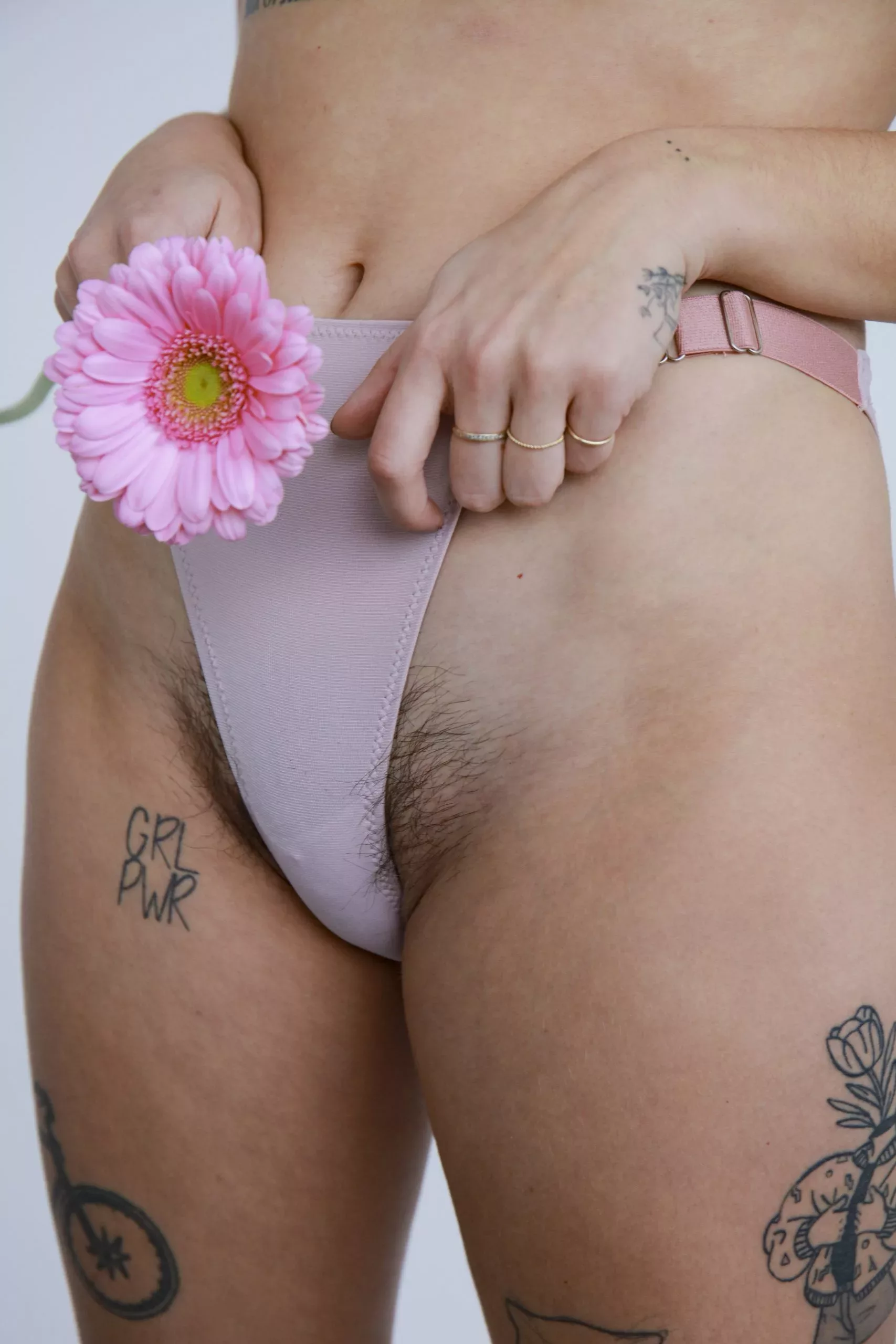Your cart is currently empty!

Hairs of Discord: How I Lost My Instagram Account
On January 21, 2021, a photo I posted on Instagram went viral.
A picture of my pubic hair.
So simple, yet so… disturbing. Let’s just say that, out of everything I publish, I never thought I’d get famous for a pic of my pubes, but the message I wanted to convey definitely resonated with a huge amount of people. All I was trying to say was that it’s okay to have a human body that looks like a human body.
Here’s part of the caption that accompanied my photo:
“If someone would have told me a year ago that I would post a photo like this one on the internet, I would have laughed, but like… really laughed.
As soon as I started growing hair, I was made to feel ashamed of it. To hide it. Most importantly, to shave it. And I’m not talking about society, advertisements, or the stuff I was consuming.
I’m talking about a father figure. A grown-up I trusted and admired. Someone who I presumed possessed the ultimate truth. Someone who (awkwardly) thought he was doing this to protect me and simply didn’t know any better.
I’m not angry. I’m actually disappointed that our society made my parent think this was good advice, and that it forced all this unease on my 10-year-old self. I learned from a young age to hate myself. I shaved every morning, never missing a day.
Reflecting on my social media use, I push myself to be more vulnerable and authentic, to have more human and open-hearted conversations. No one can decide for us how we present ourselves, whether it’s body hair, acne, mental health, gender, or whatever else we can think of.
I want to keep posting more honest stuff like this, because it’s important and because I think it’s fundamentally needed.
This is the most stress-inducing photo I’ve ever posted on Instagram—and I’ve posted many times about my medication and my acne. I love my body hair. I haven’t shaved my pubic hair in several years, and I only trim it when I feel like it, for my own comfort and pleasure.
In the summer, on the other hand, I tend to shave the sides and cut off what “sticks out” from my clothes. I’m still inclined to try to hide it out of shame and discomfort, for fear that someone will notice it. I’m really exhausted from feeling this need to hide, and it inspired me to ask my partner to take this picture.”
In my post, I then go on about the extraordinary luck I have to be able to share my life, my ideas, my projects, and all my vulnerabilities with my partner, and that he encourages and supports me.
The importance of representation
In less than two weeks, the photo garnered nearly 15,000 likes, over 4,000 saves and shares, and over 500 comments. The caption has been translated into three languages. I received hundreds of private messages thanking me, telling me how much people, mostly women, needed to read a message like this and how grateful they were to me. I persisted in responding to each person that, on the contrary, it was I who was thankful for having the opportunity to develop a growing community that is open to my vulnerability.
I often talk about the importance of representation. My post is a perfect example.
Obviously, we need to discuss the “shocking” aspect of the photo.
Deconstructing what society has imposed on us takes time and a lot of work. This effort must go hand in hand with increased representation. What shocks us is simply what we aren’t “used to” seeing. We talk a lot about body hair, of course, but we never see it. And that’s a problem.
Simply stating that body hair is normal is not enough and it’s not the same thing as daring to show it—and you need to see it if you ever want to get used to it.
Getting used to seeing, having, owning, and loving body hair can be done by normalizing it through representation.
I invited people who were shocked by my photo (and who took the time to comment on it) to reflect on their reaction.
Did it arouse discomfort? Personal unease, feelings of awkwardness or uncertainty? A sense of modesty when it comes to Internet use? A desire for the application of a more conservative policy?
But why not be just as outraged at the sight of photos in which people’s body hair has been meticulously airbrushed? Is what is disturbing, then, simply the fact that the hair was pubic? No one dared to answer.
Sowing discord
It goes without saying that I received comments about my personal hygiene and about the “fact” that I’d never be able to find a partner. I was lucky that Dr Staci (@dr.staci.t on Instagram) supported me in her stories and in the comments, stating that hygiene and body hair actually go hand in hand: hair protects us. The misconception that body hair is unhygienic stems from popular media devoid of authentic bodies, from porn that childifies women, and, as the Abattoir Facebook page put it, stems directly from the diktats of men’s (cis and straight) sexual preferences being imposed on women’s bodies (these preferences are further influenced by dominant representations of female hairlessness in porn and popular media). That said, hair removal is a matter of personal choice.
I have also been accused of faux feminism. I am regularly disappointed by the lack of intersectionality of some people who identify as “feminist”. They seem to believe that by normalizing body hair, we discriminate against people who choose to shave. On the contrary, you do you, and all I ask is to be equally represented and have my choices respected: to also be able to feel like part of the norm.
It’s erroneous to believe that proudly keeping and showing our body hair is unfeminist. My feminism aspires to be inclusive, intersectional, open, ready to question what I believe, and always eager to point out the consequences of a capitalist patriarchy responsible for body shame. My feminism also includes active listening and the desire to continue to educate myself.
In the end, in my opinion, the purpose of representation is to validate all bodies and sexualities and to ensure that people no longer have negative knee-jerk reactions to topics that are so relevant to us all.
In the crosshairs of censorship
Much to my dismay, Instagram deleted my @leksendrine account. I have never received any warning that I was breaking any rules. Yet, I woke up one morning and, poof, all my work had been thrown in the trash.
I had made the mistake of responding to a hateful comment on my gender identity. The person said that they had no problem with body hair, but that we are all either men or women – nothing else – and that I was therefore a strong woman representing female body hair.
Then, a masculinist joined in, offering me money to go buy razors. I thought I was being funny by posting a link to my PayPal. A few minutes later, there were five of them posting comments, and I realized my mistake. Apparently it’s something masculinists and trolls do in their spare time; getting together and denouncing feminist/activist/etc. pages until they get shut down.
Well, they succeeded. They won.
I woke up the next morning with a message from Instagram: “Your page has been disabled”.
At the time, I felt defeated. On the other hand, it proved my point very well: that visual representation is more powerful and shocking than speech. So we win by investing in it, by creating the authentic content that we want to see. And I will try to regain access to my page and, meanwhile, continue to write and create.
18 days of waiting
As this article is about to be published, after 18 days of emails, complaints, and requests to those around me to file a complaint with Instagram because my account had been unjustly deactivated, I am finally back! My account has finally been reactivated. I won the battle, but definitely not the war on censorship, and I’m not done fighting for all the marginalized voices that get censored.
-
Butler, S., Smith, N., Collazo, E., Caltabiano, L., & Herbenick, D. (2015). Pubic hair preferences, reasons for removal, and associated genital symptoms: Comparisons between men and women. The Journal of Sexual Medicine, 12(1), 48–58. doi: 10.1111/jsm.12763
Cohen, R., Fardouly, J., Newton-John, T., & Slater, A. (2019). #BoPo on Instagram: An experimental investigation of the effects of viewing body positive content on young women’s mood and body image. New Media & Society, 21(7), 1546–1564. https://doi.org/10.1177/1461444819826530
Craig, L., & Gray, P. (2018). Pubic hair removal practices in cross-cultural perspective. Cross-Cultural Research, 53(2), 215–237. doi: 10.1177/1069397118799298
Crenshaw, K. (1989). Demarginalizing the intersection of race and sex: A Black feminist critique of antidiscrimination doctrine, feminist theory and antiracist politics. University of Chicago Legal Forum, 8(1), 139–167. https://chicagounbound.uchicago.edu/cgi/viewcontent.cgi?article=1052&context=uclf
Daguzan Bernier, M. (2021, 5 March). Réseaux sociaux: pourquoi censure-t-on la sexualité? La tête dans le cul. https://latetedanslecul.info/censure-reseaux-sociaux-sexualite/
DeMaria, A. L., Flores, M., Hirth, J. M., & Berenson, A. B. (2014). Complications related to pubic hair removal. American Journal of Obstetrics and Gynecology, 210(6), 528.e1–528.e5. https://doi.org/10.1016/j.ajog.2014.01.036
Fahs, B. (2014). Genital panics: Constructing the vagina in women’s qualitative narratives about pubic hair, menstrual sex, and vaginal self-image. Body Image, 11(3), 210–218. doi: 10.1016/j.bodyim.2014.03.002
Gaither, T., Awad, M., Osterberg, E., Rowen, T., Shindel, A., & Breyer, B. (2016). Prevalence and motivation: Pubic hair grooming among men in the United States. American Journal of Men’s Health, 11(3), 620–640. doi: 10.1177/1557988316661315
Gaither, T., Fergus, K., Sutcliffe, S., Cedars, B., Enriquez, A., & Lee, A. et al. (2020). Pubic hair grooming and sexually transmitted infections: A clinic-based cross-sectional survey. Sexually Transmitted Diseases, 47(6), 419-425. doi: 10.1097/olq.0000000000001176
Grady, C. (2018, 20 July). The waves of feminism, and why people keep fighting over them, explained. Vox. https://www.vox.com/2018/3/20/16955588/feminism-waves-explained-first-second-third-fourth
Herzig, R. (2015), Plucked: A history of hair removal. New York University Press.
Holland, G., & Tiggemann, M. (2016). A systematic review of the impact of the use of social networking sites on body image and disordered eating outcomes. Body Image, 17, 100–110. doi: 10.1016/j.bodyim.2016.02.008
Li, A., & Braun, V. (2016). Pubic hair and its removal: A practice beyond the personal. Feminism & Psychology, 27(3), 336–356. doi: 10.1177/0959353516680233
Lyson, H. C., Le, G. M., Zhang, J., Rivadeneira, N., Lyles, C., Radcliffe, K., … & Centola, D. (2019). Social media as a tool to promote health awareness: results from an online cervical cancer prevention study. Journal of Cancer Education, 34(4), 819–822. https://doi.org/10.1007/s13187-018-1379-8
Marks, D. H., Hagigeorges, D., Manatis‐Lornell, A. J., Dommasch, E., & Senna, M. M. (2019). Excess hair, hair removal methods, and barriers to care in gender minority patients: A survey study. Journal of Cosmetic Dermatology, 19(6), 1494–1498. https://doi.org/10.1111/jocd.13164
Rowen, T. S., Gaither, T. W., Awad, M. A., Osterberg, E. C., Shindel, A. W., & Breyer, B. N. (2016). Pubic hair grooming prevalence and motivation among women in the United States. JAMA dermatology, 152(10), 1106–1113. doi:10.1001/jamadermatol.2016.2154
Schick, V.R., Rima, B.N., & Calabrese, S.K. (2011). Evulvalution: The portrayal of women’s external genitalia and physique across time and the current Barbie Doll ideals. Journal of Sex Research, 48(1), 74–81. https://doi.org/10.1080/00224490903308404
Smelik, A. (2015). A close shave: The taboo on female body hair. Critical Studies in Fashion & Beauty, 6(2), 233–251. https://doi.org/10.1386/csfb.6.2.233_1
Stone, N., Graham, C., & Baysal, I. (2017). Women’s engagement in pubic hair removal: Motivations and associated factors. International Journal of Sexual Health, 29(1), 89–96. https://doi.org/10.1080/19317611.2016.1228727
Trager, J. D. K. (2006). Pubic hair removal—pearls and pitfalls. Journal of Pediatric and Adolescent Gynecology, 19(2), 117–123. https://doi.org/10.1016/j.jpag.2006.01.051
Williamson, H. (2015). Social pressures and health consequences associated with body hair removal. Journal of Aesthetic Nursing, 4(3), 131–133. https://doi.org/10.12968/joan.2015.4.3.131






